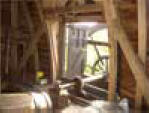An attractive woodland habitat next to the mill
supports a wide range of wildlife.
Bursledon Windmill is signposted from junction 8 on
the M27. Follow the signs from the motorway to the
roundabout and take first left onto the A27.
Windmill Lane is the first on the left.
The first windmill was built on this site in
1766-1767 by William Fry. Some of its wooden
machinery was incorporated in the present mill,
which was built during 1813-14 at a cost of about
£800.
A Mrs Phoebe Langtry was responsible for its
construction, and her son William was miller for
many years.
 The Windmill formed a part of the 'golden years' of
English agricultural prosperity in the mid 19th
century processing wheat from the surrounding area
into flour for local bakers, ships biscuits and
household use, and making animal feed from locally
grown barley and oats. It last worked in the late
1880s.
The Windmill formed a part of the 'golden years' of
English agricultural prosperity in the mid 19th
century processing wheat from the surrounding area
into flour for local bakers, ships biscuits and
household use, and making animal feed from locally
grown barley and oats. It last worked in the late
1880s.
Like many other windmills, it was made redundant by
major changes in flour milling technology. This
coincided with a prolonged depression in agriculture
which began in the late 1870s, and Bursledon
Windmill was an early casualty of the period. Major
repairs were needed, but it was no longer worthwhile
to undertake them. After the 1880s the mill fell
into disrepair.
The last miller was a George Gosling, who bought the
Windmill in 1872 and set up as a threshing
contractor. His decision to replace the cap with a
flat roof preserved the internal machinery long
after the stocks and sails had been removed.
